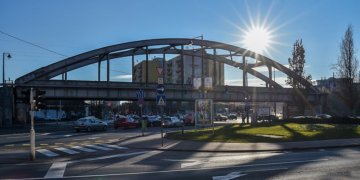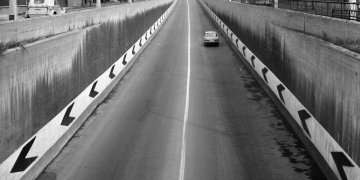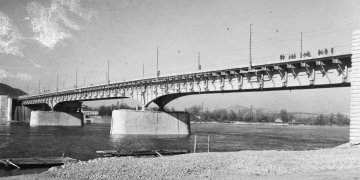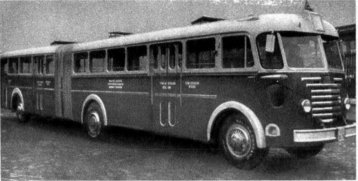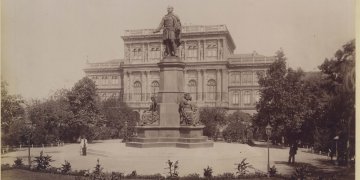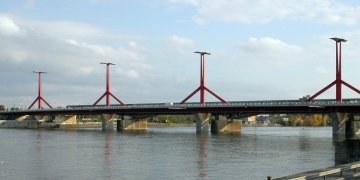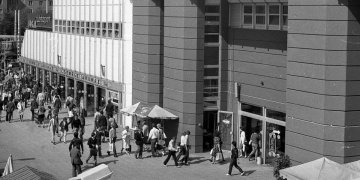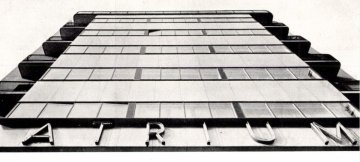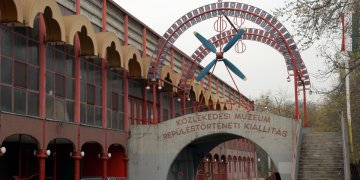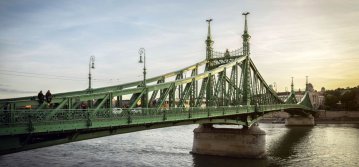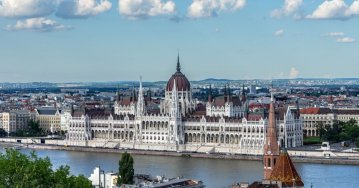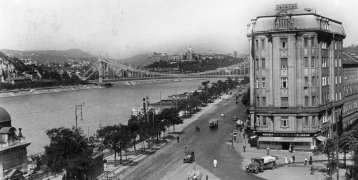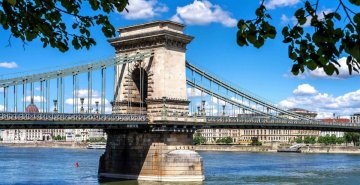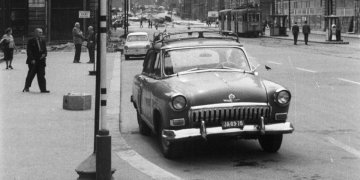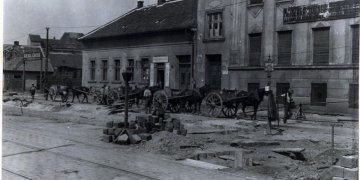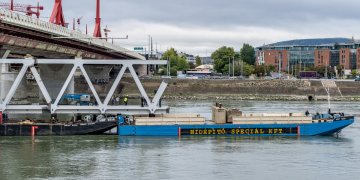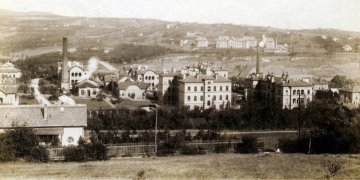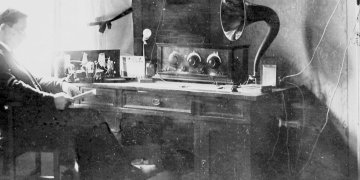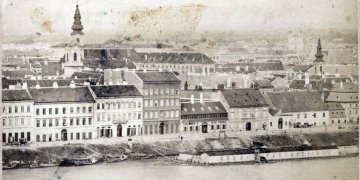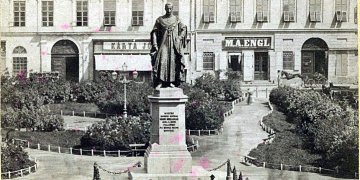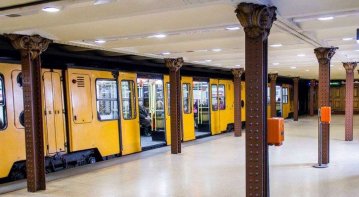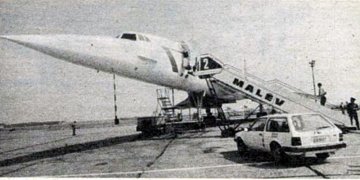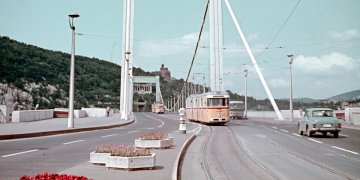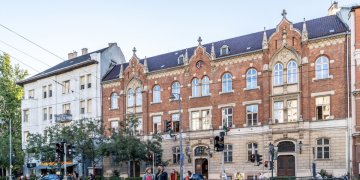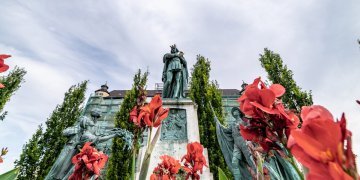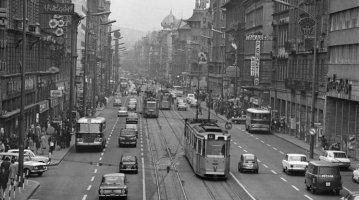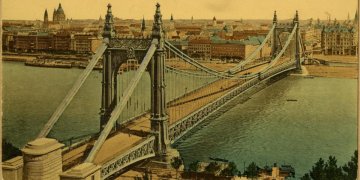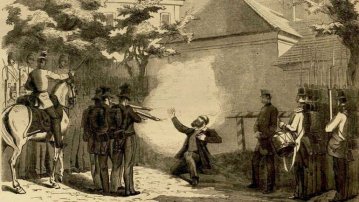
Domonkos Csaba
Cikkek
A new bridge in the heart of the 11th District
November 18, 2020 at 9:00 AM
A rail bridge has crossed above the intersection of Tétényi Road – Bartók Béla Road and Karolina Road in the 11th District for 71 years. In connection to the development of the Southern Ring Railway, a longer and wider railway overpass is being built. The goal is to convert the newly gained space underneath into an urban plaza, with trees and greens, and ample room for pedestrians, cyclists and public transport passengers to move through freely.
Fifty years in the works: Airport express road to become dual-carriageway
November 11, 2020 at 11:00 AM
Although not many people are travelling by plane during the pandemic, everyone agrees that better transport is needed between Liszt Ferenc International Airport and the Budapest city centre. A new rail connection to the airport is in the works, and now a design tender for expanding the expressway to the airport to two lanes in each direction has been announced. But how has Budapest grown out of the road that served the airport for decades?
Once known as Stalin Bridge, Árpád Bridge turns 70
November 9, 2020 at 9:00 AM
Its construction was abandoned during the Second World War. It bore Stalin's name for six years and was the longest bridge in the country for years. Árpád Bridge is now seventy years old.
Sixty years of articulated buses in Budapest
November 6, 2020 at 9:00 AM
There were not enough buses in the Budapest of the 1950s, and those that were in use were too small. Decision-makers expected a quick solution from Ikarus but the Hungarian bus manufacturer only promised to offer a large articulated bus in the middle of the 1960s. The Budapest bus workshop was unwilling to wait. They built over 300 articulated buses themselves.
45 years under ground – A museum on Deák Square about the Millennium underground Railway
November 4, 2020 at 3:00 PM
A museum housed in an abandoned underground tunnel, filled with original rolling-stock, and a slew of objects from the history of one the world's oldest underground railways. All of this for the price of a single ticket in the middle of the city, under Deák Square. The Millennium Underground Museum opened 45 years ago.
The Hungarian Academy of Sciences turns 195
November 3, 2020 at 5:30 PM
The imposing main building of the Hungarian Academy of Sciences stands on Széchenyi Square. The institution was founded after almost 100 years of proposals, planning and negotiations. Eventually, a 34-year-old Hussar Captain donated the money needed to create it, 195 years ago.
The memento of a World Fair never held – Rákóczi Bridge turns 25
October 29, 2020 at 9:00 AM
Budapest's first permanent urban bridge built since the end of World War II was completed 25 years ago after 30 different plans were drawn up and 20 years of preparation. It was not welcomed unanimously by Budapest's residents, and the world fair that had been the reason behind its location was never held.
Jump over to Sugár – Forty years of an iconic shopping centre
October 26, 2020 at 12:00 PM
The socialist shopping centre opened on örs Vezér Square forty years ago. While Terminal originally one the contest announced to find a name, the city council eventually named the 29-thousand square metre shopping centre Sugár. Filled with the state-owned shops of the era the store brought several novelties. Home delivery could be requested on certain items, pre-orders could be placed, and the upper floors were wheel-chair accessible. The hit slogan, Csak egy ugrás a Sugár (loosely, 'jump over to Sugár') became the iconic phrase of a generation.
A modern cinema for Buda – Atrium Movie Theatre completed 85 years ago
October 24, 2020 at 3:00 PM
Átrium was a unique cinema in every respect. It differed from the others in Budapest not only because of its modern building but also in how it was operated. The elegant new auditorium seated 800 people and offered a new quality in both sound and elegance when opened in 1935.
Exhibition of aerospace history opened in Petőfi Csarnok 35 years ago
October 20, 2020 at 9:00 AM
The upper floor of the Petőfi Csarnok housed the Aviation and Space Exploration exhibit of the Transport Museum for thirty years. The aeroplane used by Charles IV in his attempt to return to the Hungarian throne in 1909 and was on display, as was the World war I reconnaissance aircraft manufactured by the Lloyd factory in Aszód. Relics of the space age included the crew capsule used by Bertalan Farkas and Valeri Kubasov to return to Earth from the Salyut-6 space station. When the Petőfi Csarnok was closed, the exhibition was also forced to leave.
Green Liberty – The decision to repaint Szabadság Bridge to its original green was reached 35 years ago
October 17, 2020 at 11:00 AM
Following a tragedy in Vienna, abridge renovation project was launched in Budapest in 1979. Szabadság Bridge was slated for renovation in 1981, however, was eventually prioritised due to urgent work. Despite this, the bridge was closed again in 1985, as the original steel support columns had been corroded so significantly they became unstable. However, during this second renovation, the decision to repaint the bridge to its original green was also made.
Parliament or Palace? – Construction of the Hungarian parliament began 135 years ago
October 12, 2020 at 5:58 PM
On 12 October 1885 150 workers began to dig a 40,000-cubic-metre pit. With this construction of the Hungarian parliament building began based on plans drawn by Imre Steindl. Lasting nearly two-decades the project transformed a neglected, to-be-developed part of the city, Tömő tér, into one of the most symbolic places in the country.
Livable Budapest? The first plans were made 80 years ago
October 11, 2020 at 1:00 PM
Budapest adopted its first modern urban development plan in 1940. The massive 150-page document took eight years to prepare. Its main goal was to provide a livable environment for the inhabitants of the quickly growing city. The plan accounted for an increase in motor traffic, marked routes for underground railways, and pushed for architecturally unified residential areas. It also contained plans for the creation of community gardens in the densely populated areas of Pest and designated the embankment as an expressway for vehicles.
Liveable Budapest? The first plans were made 80 years ago
October 11, 2020 at 1:00 PM
Budapest adopted its first modern urban development plan in 1940. The massive 150-page document took eight years to prepare. Its main goal was to provide a livable environment for the inhabitants of the quickly growing city. The plan accounted for an increase in motor traffic, marked routes for underground railways, and pushed for architecturally unified residential areas. It also contained plans for the creation of community gardens in the densely populated areas of Pest and designated the embankment as an expressway for vehicles.
A bridge without a name – How Chainbridge in Budapest had no name
October 7, 2020 at 11:00 AM
Chain Bridge in Budapest had no official name until 1915 and is still known simply as Chain Bridge in everyday use. However, Lajos Kossuth proposed in 1842 at the laying of its foundation stone that the bridge be named after his great political rival, István Széchenyi, the aristocrat who initiated the construction. Others hoped to name the first permanent crossing between Buda and Pest after princes and princesses. Still, the Ministry of Finance that owned the bridge accepted none of these recommendations. Finally, Széchenyi's name was carved into the structure in 1915, when it was fully rebuilt during the First World War.
Volga taxis appeared in Budapest 60 years ago
October 5, 2020 at 10:00 AM
In the 1950s only Főtaxi, owned by the city itself, was allowed to provide taxi services in Budapest. The company had relatively few vehicles in its very diverse fleet. At the beginning of the new decade, they purchased new vehicles from the Soviet Union, which they believed would become the basic taxi in the capital. The Volga M21 was unable to fill this role, and 10 years later, another car took the streets of the capital by storm: the Zhiguli.
How a road to Vienna resulted in a re-evaluation of Budapest
October 3, 2020 at 2:00 PM
The Budapest–Vienna Highway was specifically designed for cars and opened 90 years ago, on 4 October 1930. Public opinion in the country and the capital hoped that the new road would improve Hungary's geopolitical situation and improve tourism. Perhaps not many readers know that drivers would have had to leave the capital through Bécsi Road (Bécs is the Hungarian name for Vienna) in the 3rd District to reach the Austrian capital.
New rail bridge being built between Ferencváros and Lágymányos
October 2, 2020 at 11:00 AM
The bridge being built is the sixth structure to connect the tracks on the two sides of the Danube beside Rákóczi Bridge. However, the current construction is unique, as it is similar to threading a thread through a needle. See the photos of the unique procedure below.
Hospital on the outskirts – Huge effort by 19th-century decision-makers improved healthcare
September 28, 2020 at 9:00 AM
The construction of Saint John's Hospital (Szent János Kórház) began 125 years ago, on a hillside where vineyards had once stood. The 300-bed modern hospital was much needed, as the old building of the hospital, on the present-day Széna Square, was gravely overcrowded. Doctors feared that the influx of workers to the capital caused by the construction of projects connected to the upcoming national millennium would lead to catastrophe.
95 years of radio broadcasts in Budapest
September 24, 2020 at 11:00 AM
Hungarian radio had a difficult start. In its first years, listening to the radio without a license was a punishable offence, and permission to access the service was even required later. In the autumn of 1925 chaos reigned: the radio tower in Csepel had been completed, and the studio in Budapest was also being built, but many listened to the experimental broadcasts without permission and ended up in court.
Life underground – Significant population of Pest and Buda lived in cellars before the unification of the cities
September 18, 2020 at 10:00 AM
A census was conducted in Hungary in 1870, 150 years ago. It paints a stunning picture of Buda a Pest before the two cities were unified. Barely 200,000 people lived on the Pest side, and nearly 54 thousand on the Buda side. 15-thousand people lived in cellars, and 13,000 shared their rooms with at least ten other people. The census details how many doctors, writers, teachers lived in the cities, as well as how many unmarried or divorced women called the city home. Two centenarians lived in the city that was experiencing a massive development boom. It was a unique time, in which poverty and grandeur coexisted, and when the Renaissance revival homes so loved to this day were built.
The most Hungarian Habsburg moved to Buda 225 years ago
September 17, 2020 at 11:00 AM
Eventually serving as Palatine of Hungary for over 50 years, the young prince being raised in Florence would never have been expected to later be known as the Most Hungarian Habsburg. Palatine Joseph was only 19 when he moved to Budapest with much ceremony 225 years ago. He settled in the country, lived here with his wife and children, died here and was buried in the crypt of the Royal Palace in Buda Castle. His popularity was founded on the attention he paid to the prosperity of Buda and Pest.
Once a miracle of the National Millennium it was covered by graffiti a hundred years later
September 14, 2020 at 9:00 AM
Built under only 20 months, the first of its kind on the continent and tried by the King. The Millennium Underground Railway, commonly known as the kisföldalatti "small underground" may be Budapest's most likeable means of public transport. It most recent major renovation was finished 25 years ago.
Masses flocked to see the Concorde that landed at Ferihegy
September 13, 2020 at 11:00 AM
The Concorde may be the most impressive passenger aircraft ever created. Flying at twice the speed of sound, it could cross the Atlantic in only three hours. These miracles of a machine visited Budapest several times. The first landed at Ferihegy 35 years ago on 14 September 1985.
A debate raging since the 19th century: Trams on Budapest bridges
September 10, 2020 at 11:00 AM
The question of running tracks across Margaret Bridge lead to a major debate during its construction, while trams only started running on Rákóczi bridge 20 years after its construction. Original plans for the bridge to be constructed near Galvani Street did not allocate rooms for trams. Nevertheless, it seems certain that guided transportation connections between Buda and Pest will remain for decades to come.
A street of celebrities – Writers, painters and inventors once lived along Bartók Béla Road
September 7, 2020 at 1:00 PM
There is a part of Budapest where a car factory, a barracks, university halls of residence, and the entirety of Hungarian literary life in the inter-war years lived peacefully side-by-side. All within 100 metres of each other. A small section of a wonderful road with wonderful places: the stretch of Bartók Béla Road between Szent Gellért [Saint Gerard] Square and the Körtér.
Statue of Saint Emeric unveiled 90 years ago – Despite several plans, the memorial was never moved
August 16, 2020 at 10:00 AM
The statue of Saint Emeric erected in 1930 has survived the storms of history. Later it survived the battles of 1956 and the attacks of the socialist ideology untouched. Although its demolition was raised several times, the statue by Zsigmond Kisfaludi Strobl still stands where it was unveiled 90 years ago, as part of the events commemorating the 900th anniversary of Saint Emeric's death.
Motorways through the city – Fifty years ago prioritising cars was a modern choice
August 13, 2020 at 10:00 AM
A few decades ago, a highway network was planned to criss-cross the city centre. Motorists could have passed through the city centre without hindrance and reached the motorways leading out of the city, which would also have been connected by a two-level ring motorway. Today, when the goal is to have as few cars as possible in the city centre, the plans from 50 years ago are interesting.
How have the bridges of Budapest changed after their construction?
August 10, 2020 at 12:00 PM
Pestbuda's summary presenting the reconstruction of the Chain Bridge in 1914 received many comments about the bridges of Budapest, their modifications and redesigns. Please join us on a glance through which bridge has changed in the decades since its construction.
Lajos Batthyány's public reburial took place 150 years ago – The 42-year-old Prime Ministers was buried in secret after being executed
August 5, 2020 at 1:00 PM
The execution of Count Lajos Batthyány, the first elected Hungarian prime minister, remains an indescribable act of retaliation after the war of independence. The prime minister was buried in secret and then reburied publicly 21 years later, in 1870, with great pomp. The nation laid him to rest in a funeral fitting the difficult diplomatic solution worthy of a great politician.

